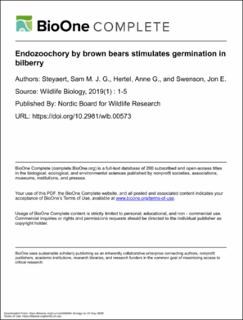| dc.description.abstract | The understory vegetation of the Eurasian boreal forest is dominated by several ericaceous species (e.g. bilberry Vaccinium myrtillus). These species invest large amounts of energy in their sexual reproduction by producing seed-containing berries, which are apparent adaptations for endozoochory. Their seedlings are, however, almost never found in the wild, and they reproduce virtually exclusively through clones. Brown bears Ursus arctos consume enormous amounts of ericaceous berries (predominantly bilberry in central Scandinavia) during hyperphagia, and may facilitate sexual reproduction in such species. If ericaceous species would benefit from endozoochory by brown bears, one would predict that endozoochory would have no negative impacts on germination. We experimentally evaluated this prediction using germination trials under controlled conditions of bilberry seeds that were 1) extracted from brown bear feces, 2) extracted from ripe berries and 3) contained in berries. Using time-to-event analyses, we showed that passing the gut by itself did not stimulate or limit germination. However, seeds that were released from the berries germinated about one month earlier compared to seeds contained in berries. This implies that being released from a fruit, for example through endozoochory, can have a large temporal germination and growth advantage, especially in northern ecosystems a with short growing season. | |
